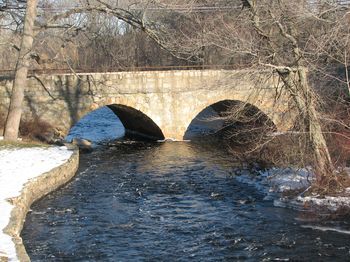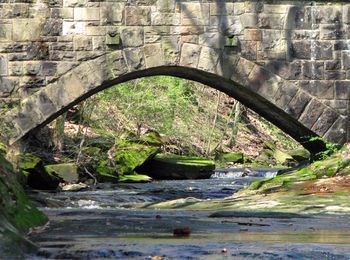Arch Bridge - Types of Arch Bridges
Arch bridge is one of the most popular types of bridges, which came into use over 3000 years ago and remained in height of popularity until industrial revolution and invention of advanced materials enabled architect to create other modern bridge designs. However, even today arch bridges remain in use, and with the help of modern materials, their arches can be build on much larger scales.
The basic principle of arch bridge is its curved design, which does not push load forces straight down, but instead they are conveyed along the curve of the arch to the supports on each end. These supports (called abutments) carry the load of entire bridge and are responsible for holding the arch in the precise position unmoving position. Conveying of forces across the arch is done via central keystone on the top of the arch. Its weight pushes the surrounding rocks down and outward, making entire structure very rigid and strong.

Because of this design, stone and wood arch bridges become very popular during the Roman Empire, whose architects managed to build over 1000 stone arch bridges in Europe, Asia and North Africa. Many of those bridges remain standing even today, giving us the chance to personally see the wonders of the ancient architecture. Roman designs were usually made with semicircular arches, although several segmented arch bridges were made during their reign. These segmental arch bridges had one crucial design advantage which separated them from ordinary semicircular bridges – they enabled bridge builders to more arch of the bridge much higher and lower the mass of the entire structure. These changes enabled bridges to much easier survive stresses of floods and strong rivers. During the life of Roman Empire, they built many wondrous bridges, lengthy aqueducts with multiple arches, bridges with flood openings on the piers, and many others.
As centuries went on, medieval architects improved the designs of Romans, creating arch bridges with narrower piers, thinner arch barrels, lower span-rise rations, pointed arches, and increased spans of arches (increasing to over 70 meters, most famously on the bridge at Trezzo sull'Adda who was in use from 17th to the end of 18th century). Renaissance architects infused into arch bridges not only sound engineering, but also fashion of their time, creating some of the most beautiful and famous bridges of the modern human civilization (such as Rialto Bridge in Venice). In the last 150 years, iron, steel and concrete enabled creation of much more ambitious arch bridges which can now be seen in every country in the world.
Types of Arch Bridges
- Corbel arch bridge – Even though Corbel arch does not function in the same way as true arch bridges (they are not conveying forces across the arch), they can be created to look very similar like them. They are made by laying successive layers of masonry or stone with each having successfully larger cantilevers.
- Aqueducts and canal viaducts – To bridge large distances, ancient romans built series of supports which were connected with stone arches. These series of arched structures were butt not only in one layer like ordinary bridge, but with several layers that could reach very impressive heights.

- Deck arch bridge – Common arch bridge in which deck is situated on top of the arch.
- Through arch bridge – Arch Bridge in which deck is not situated completely above the arch, but it travels in one part below it and is suspended to it via cables or tie bards. Famous Sydney Harbour Bridge is the best example of this design.
- Tied arch bridge – Also known as bowstring arch bridge, it incorporates a tie between two opposite ends of the arch.

